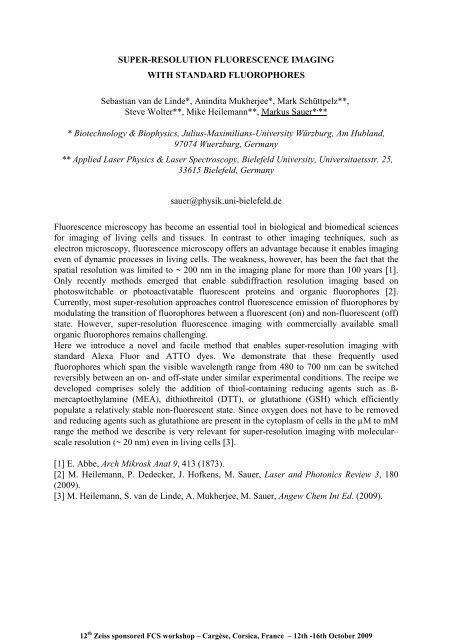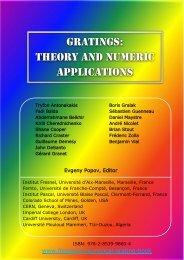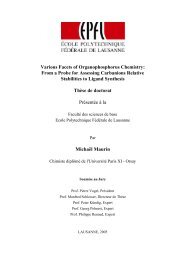12th Carl Zeiss sponsored workshop on ... - Institut Fresnel
12th Carl Zeiss sponsored workshop on ... - Institut Fresnel
12th Carl Zeiss sponsored workshop on ... - Institut Fresnel
Create successful ePaper yourself
Turn your PDF publications into a flip-book with our unique Google optimized e-Paper software.
SUPER-RESOLUTION FLUORESCENCE IMAGING<br />
WITH STANDARD FLUOROPHORES<br />
Sebastian van de Linde*, Anindita Mukherjee*, Mark Schüttpelz**,<br />
,<br />
Steve Wolter**<br />
, Mike Heilemann**<br />
, Markus Sauer*<br />
**<br />
* Biotechnology & Biophysics, Julius-Maximilians-University Würzburg, Am Hubland,<br />
97074 Wuerzburg, Germany<br />
** Applied Laser Physics & Laser Spectroscopy, Bielefeld University, Universitaetsstr. 25,<br />
33615 Bielefeld, Germany<br />
sauer@physik.uni-bielefeld.de<br />
Fluorescence microscopy has become an essential tool in biological and biomedical sciences<br />
for imaging of living cells and tissues. In c<strong>on</strong>trast to other imaging techniques, such as<br />
electr<strong>on</strong> microscopy, fluorescence microscopy offers an advantage because it enables imaging<br />
even of dynamic processes in living cells. The weakness, however, has been the fact that the<br />
spatial resoluti<strong>on</strong> was limited to ~ 200 nm in the imaging plane for more than 100 years [1].<br />
Only recently methods emerged that enable subdiffracti<strong>on</strong> resoluti<strong>on</strong> imaging based <strong>on</strong><br />
photoswitchable or photoactivatable fluorescent proteins and organic fluorophores [2].<br />
Currently, most super-resoluti<strong>on</strong> approaches c<strong>on</strong>trol fluorescence emissi<strong>on</strong> of fluorophores by<br />
modulating the transiti<strong>on</strong> of fluorophores between a fluorescent (<strong>on</strong>) and n<strong>on</strong>-fluorescent (off)<br />
state. However, super-resoluti<strong>on</strong> fluorescence imaging with commercially available small<br />
organic fluorophores remains challenging.<br />
Here we introduce a novel and facile method that enables super-resoluti<strong>on</strong> imaging with<br />
standard Alexa Fluor and ATTO dyes. We dem<strong>on</strong>strate that these frequently used<br />
fluorophores which span the visible wavelength range from 480 to 700 nm can be switched<br />
reversibly between an <strong>on</strong>- and off-state under similar experimental c<strong>on</strong>diti<strong>on</strong>s. The recipe we<br />
developed comprises solely the additi<strong>on</strong> of thiol-c<strong>on</strong>taining reducing agents such as ßmercaptoethylamine<br />
(MEA), dithiothreitol (DTT), or glutathi<strong>on</strong>e (GSH) which efficiently<br />
populate a relatively stable n<strong>on</strong>-fluorescent state. Since oxygen does not have to be removed<br />
and reducing agents such as glutathi<strong>on</strong>e are present in the cytoplasm of cells in the µM to mM<br />
range the method we describe is very relevant for super-resoluti<strong>on</strong> imaging with molecular–<br />
scale resoluti<strong>on</strong> (~ 20 nm) even in living cells [3].<br />
[1] E. Abbe, Arch Mikrosk Anat 9, 413 (1873).<br />
[2] M. Heilemann, P. Dedecker, J. Hofkens, M. Sauer, Laser and Phot<strong>on</strong>ics Review 3, 180<br />
(2009).<br />
[3] M. Heilemann, S. van de Linde, A. Mukherjee, M. Sauer, Angew Chem Int Ed. (2009).<br />
12 th <str<strong>on</strong>g>Zeiss</str<strong>on</strong>g> <str<strong>on</strong>g>sp<strong>on</strong>sored</str<strong>on</strong>g> FCS <str<strong>on</strong>g>workshop</str<strong>on</strong>g> – Cargèse, Corsica, France – <str<strong>on</strong>g>12th</str<strong>on</strong>g> -16th October 2009













